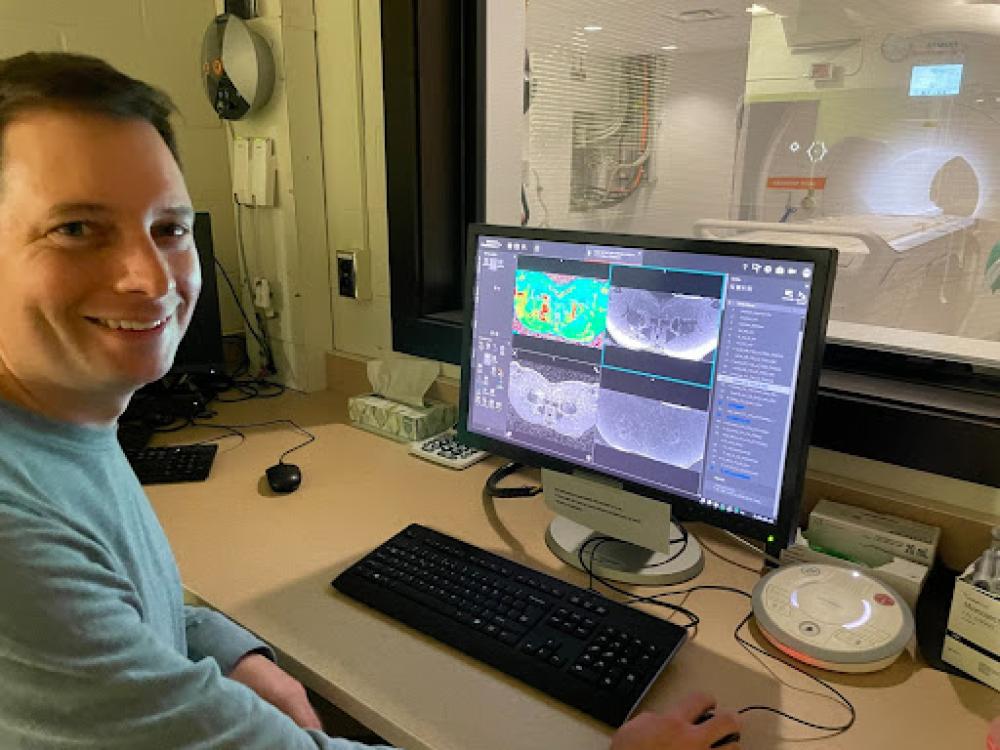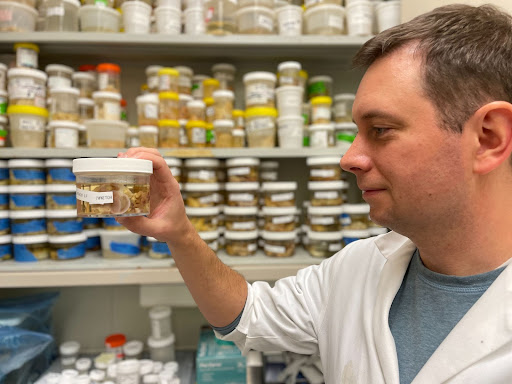Casey Johnson is not a veterinarian. But he’s very much at home as a researcher at CVM
November 1, 2023

When asked how his current projects reflect his underlying scientific interests, Casey Johnson says, “I really like studying dynamic processes. I’m not interested in measuring a static disease, but in understanding progression and the interaction of different factors.” If dynamism, progression, and interaction are apt descriptors for his scientific interests, they also capture the spirit he brings to his work.
Johnson arrived at CVM in July of 2019 with a background some might consider unconventional for a faculty member at a veterinary medical college. As an undergraduate at Saint Olaf College he majored in physics and math, and then went on to earn a PhD in biomedical engineering at the Mayo Clinic. From there, he pursued brain imaging at the University of Iowa as a postdoctoral researcher, and he then joined the University of Minnesota Center for Magnetic Resonance Research (CMRR) as a research associate and was introduced to musculoskeletal imaging.
“My background is in physics and math, but I’ve always had an interest in biology and medical applications, so that drew me to medical imaging as a really nice way to maintain that technical physics core, while also working on something that's translational and can have an impact,” Johnson describes.
While at the CMRR, he received a K01 career development award from the National Institutes of Health (NIH), providing five years of support that would allow him to launch into an independent investigator role. At the same time, a faculty position opened up at CVM that offered a unique opportunity.
The vision for the position was to “be a bridge to human research, and to benefit the medical imaging section at the CVM with expertise in newer imaging technologies,” said Johnson. “They wanted someone who could help to support collaborative, intercollegiate research projects while also helping to advance research, training, and clinical care in the CVM.”
The position is a great match, he says, for his interests in both the technical side of medical imaging and in interdisciplinary collaboration. It has exceeded his expectations—and he has grown it accordingly.
With additional research funding from the NIH, Johnson and his team are studying osteonecrosis of the femoral head, a condition where blood supply to the bone is cut off, and the femoral head collapses. The condition affects young adults and children (in children, it’s called Legg-Calve-Perthes disease), and it often leads to hip replacements and multiple follow-up surgeries at a young age.
One crucial focus of the current research is developing and validating new MRI methods to help better detect and monitor early manifestations of the disease. Going forward, Johnson will also be focused on helping develop and evaluate an animal model that can better model the spectrum of disease in children, in order to better tailor treatment to the individual child. “The only way we’re going to move the needle clinically is to validate treatments in a preclinical model so we can say ‘this is likely to work,’” Johnson describes. And imaging plays a primary role in that validation.

The research into Legg-Calve-Perthes disease is one of a collection of projects Johnson leads involving developmental joint disorders. As much as the subject matter interests him, his collaboration with other researchers is what truly drives him. ”Without strong collaborations, it’s ever more difficult to push things forward as the science gets more complex,” he says.
In addition to his primary CVM collaborators, who include Cathy Carlson, Ferenc Toth, and Alex Armstrong, he also partners with researchers from the Medical School, the CMRR, and Gillette Children’s Specialty Healthcare. And with a spate of new projects in the pipeline, his team’s reach is likely to grow. The new projects include studies of intervertebral disc disease, which affects dogs and humans, and for which he has received two internal CVM grants.
“I’m made to be a lifelong academic, and along each stage of the path, I’ve loved it all the more,” Johnson describes. At this stage of his career, he is particularly engaged with grant writing, mentoring trainees, and working with other disciplines to solve problems. “I've found a great home for the mix of things I like doing,” he says. “And I attribute my happiness here at least in part to the fact that veterinarians are so nice!”


